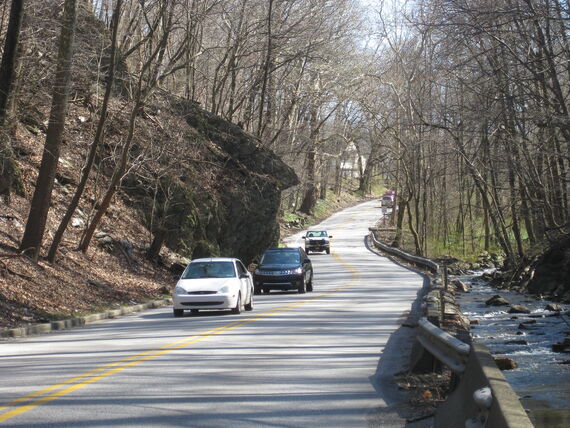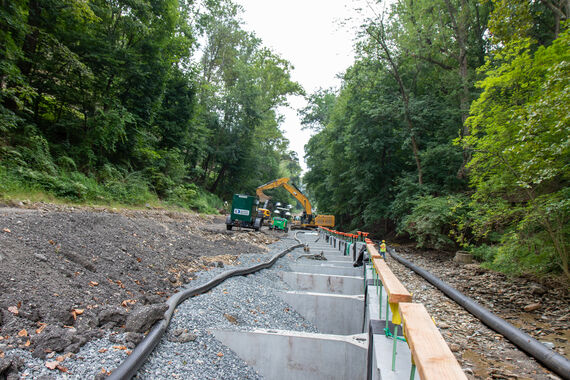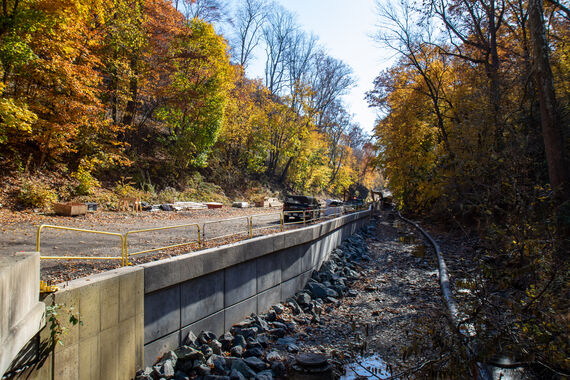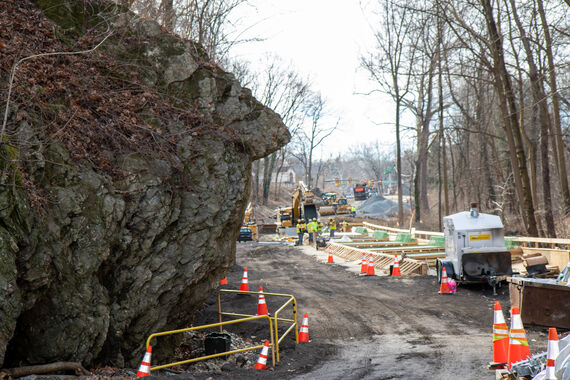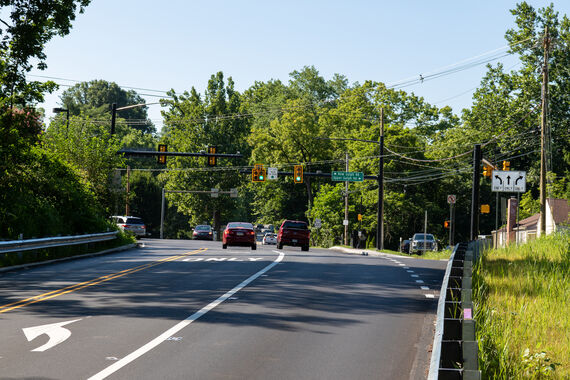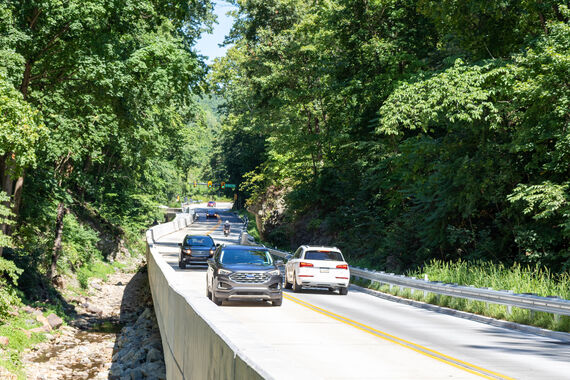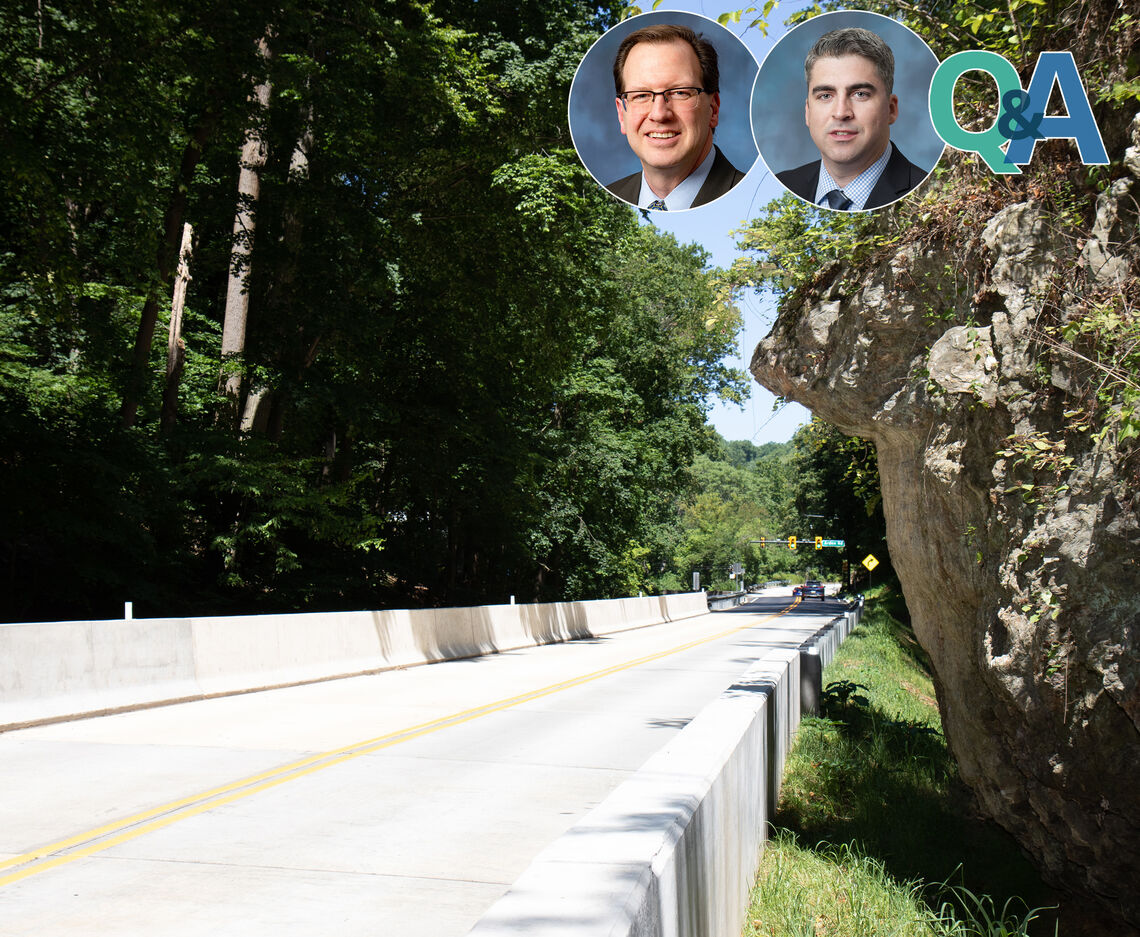
ASK THE PROJECT TEAM: ROUTE 320 (HANGING ROCK) IMPROVEMENT PROJECT
The Route 320 (Hanging Rock) Improvement Project includes a mile-long stretch of roadway along Route 320 between Arden Road and Upper Gulph Road and the intersection of Route 320 and Upper Gulph Road in Upper Merion Township, Montgomery County. Once contracted, McCormick Taylor was able to work through the project challenges and complete the preliminary engineering and final design in just three years. The project improvements included the realignment of the roadway while raising the profile to meet the 100-year flood elevation requirements, design of a cantilevered roadway section and retaining wall, and other intersection and drainage improvements.
We interviewed lead structural engineer Bryan Healy, PE and Project Manager, Michael Wintermute, PE to learn more about the project.
Tell us a little bit about the project.
Bryan: This project realigned Route 320 away from a historically protected resource, which is an overhanging rock next to the roadway. We relocated the road to take all the traffic away from any potential impacts with the rock and still keep the roadway protected from the stream - Gulf Creek. What we wound up doing was cantilevering the roadway out over the wall, away from the rock and realigning it and then bringing it back in to align it with the intersection down at the Arden Road intersection. What that involved was a cantilevered roadway slab that came out, at its largest point, about six feet across, away from the face of the wall.
Michael: This was a long-term project that has been with the department for well over 20 years. A little fun fact is, I started on this project when I was an intern in school working at PennDOT, so it has sort of come full circle.
What about the project highlights McCormick Taylor’s talents?
Michael: One would be our structures department just for the design of the wall itself and our Water Resources Group had to take into account the flooding, the hydraulics, and everything to raise the roadway. So to develop the cantilever on top of a precast wall system was very unique, and was not something that had been done a lot in the country, as well as, the state. So there was a lot of firsts on this project. We worked with the wall manufacturer to come up with the correct properties and to make sure things were going to work right. Our environmental group worked through the permitting issues. That was one of the major problems and stumbling blocks for the project in the past. Previous attempts could not get through the permitting process in order to actually finish the design. Our group did a great job completing the permit in nine months, with minimal comments from DEP and the County Conservation District. Our Highway Group took on the challenge of either eliminating the rock, or elevating and realigning the roadway; all while, considering the historic nature of the Hanging Rock. We essentially had to design the project around the rock. We raised and shifted the profile and alignment of the road away from the rock in order to make sure normal-sized vehicles and trucks could travel on the roadway.
What challenges did the team face while working on the project?
Bryan: The rock was a big challenge, and the stream itself. By cantilevering over the top of it, we had to kind of work around the flood elevations here. The retaining wall that was here originally needed to be replaced due to a lot of flooding over the years. The road was closed a few months before we finished the final design because flooding washed away all of the guide rails on the far end of the project.
And then, while the project was under construction, some heavy flooding went through here as well, and then the hurricane that came through - Ida. Remnants of Hurricane Ida washed out a lot of the early work that had been done on the wall and some of the work site that was exposed to the creek. So this is a prime example of why we designed the entire corridor above the 100-year flood elevation. Previously this flooding would have closed the road to all traffic and hampered emergency response times. Now the final product will allow the road to stay open in all weather conditions. So that's why we have a large change in the profile of the roadway.
Are there additional aspects of the project you want to mention?
Michael: The traffic signals incorporated in the project area are being linked up to the district's traffic control center with their new unified command and control. That means when there are issues on the I-76 Expressway, like an accident or weather event or something like that, and they need to divert traffic, Route 320 will be one of the major diversion routes now. They can tap into the signal system, make adjustments to try and keep all the traffic moving and things don't get backed up so they can change signal timing on the fly from the district office. They can have emergency programs already set up based on the time of day so that it is easy to make a quick adjustment.
What was your favorite part of the project?
Michael: Seeing the final product. It was quite an effort to get here. Seeing a project completely wrap up and having everyone that worked on the project be able to see the completed project is, I think, really important. A lot of people don't get a chance to see the fruits of their work. So, it's nice when you get to see something like this.
